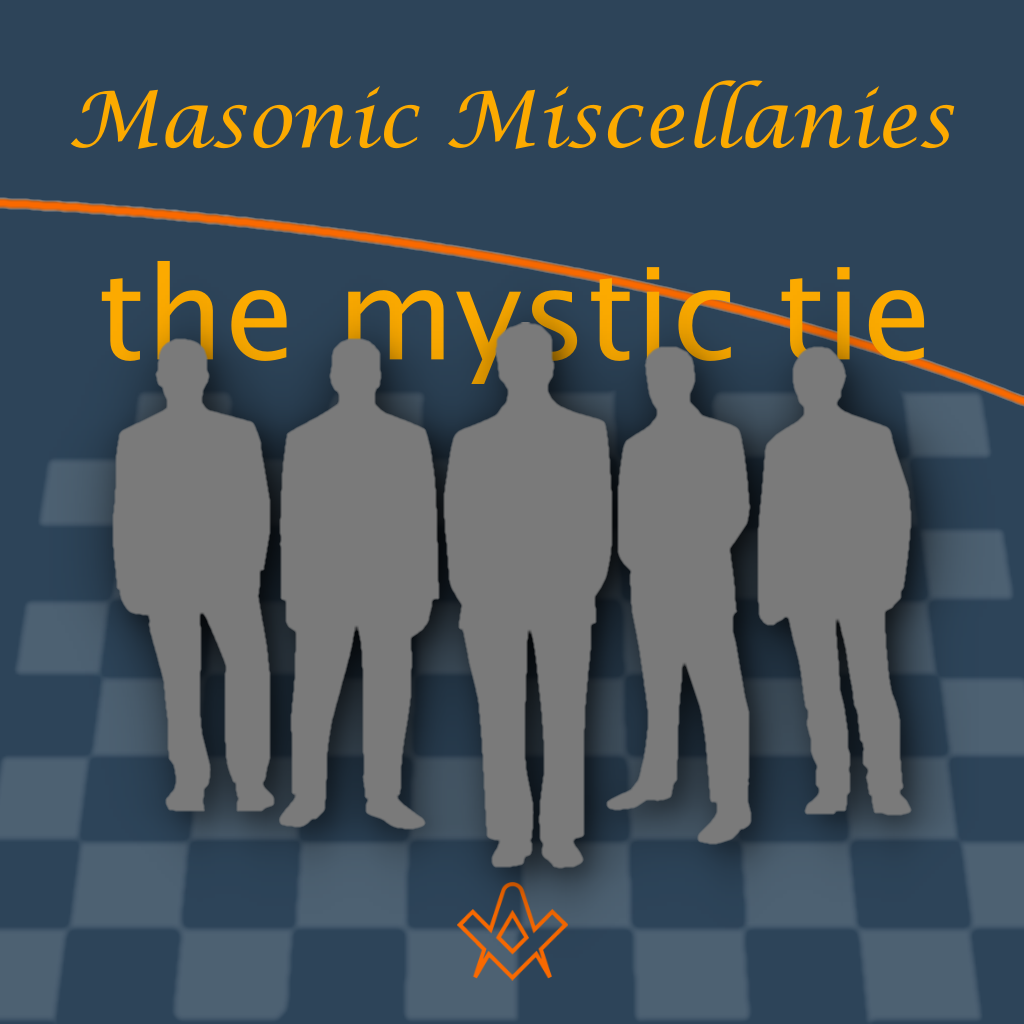That sacred and inviolable bond which unites men of the most discordant opinions into one band of brothers, which gives but one language to men of all nations and one altar to men of all religions, is properly, from the mysterious influence it exerts, denominated the mystic tie; and Freemasons, because they alone are under its influence, or enjoy its benefits, are called “Brethren of the Mystic Tie”.
– Albert Mackey
The expression was used by Brother Robert Burns in his farewell to the Brethren of Saint James Lodge, Tarbolton, Scotland:
Adieu! a heart-warm, fond adieu!
Dear Brothers of the mystic tie!
Ye favored, ye enlightened few,
Companions of my social joy!
Source: Mackey’s Encyclopaedia of Freemasonry
The Mystic Tie
From: The Builder – June, 1920
By Bro. Joseph Fort Newton, New York
The moral solidarity of mankind is dissolved. The danger is imminent that the end may be a war of all against all.
Sects and parties are increasing; common estimates and ideals keep slipping away; we understand one another less and less; even voluntary associations, that form of unity peculiar to modern times, unite more in accomplishment than disposition, bring men together outwardly rather than in reality.
These words, written by Rudolph Eucken in 1912, were like a star-shell over No Man’s Land, revealing the divided mind of the world, and they had a terrible fulfilment.
The War, by its principle of violence, made no positive contribution to society, but only stirred up and brought to the surface what already existed.
For both men and nations it intensified tendencies already active, precipitated passions held in obscure solution, and brought to a focus forces that had long been uneasily accumulating.
It neither initiated nor changed the direction in which the world was moving, but it did quicken the pace, and, in quickening it, revealed it.
That is why a haunting uneasiness possesses the minds of men today.
Even when local disturbances subside and isolated disputes are settled, we still doubt whether a stable tranquillity has returned or ever will return again.
For these things are only symptoms of a profound and widespread mental ferment and moral restlessness.
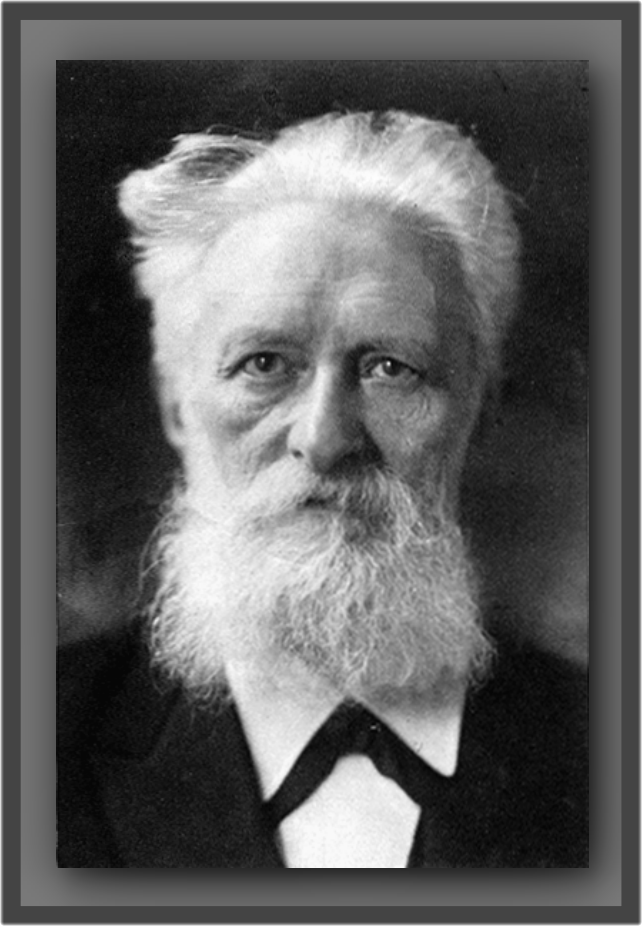
Rudolf Christopher Euken (1846-1926)
IMAGE LINKED: wikimedia Attribution 4.0 International (CC BY 4.0)
The insight of Eucken goes further back and deeper down to the real root of the matter, divining the causes and logic of it all to be moral, spiritual, religious.
For, if anything is made plain by history, it is that the mystic tie which holds humanity together in ordered and advancing life is moral and spiritual, and when that thread is cut anything may happen.
From the beginning of the century the spiritual disintegration of the modern world, the breaking of the ties that bind together the fabric of civilization, had been observed and noted by many.
Faith grew dim, moral sanctions were relaxed, and it was deemed clever and smart to talk lightly of those sanctities without which no society has long existed.
Much of our literature has been intellectually Bolshevistic for thirty years, attacking the basis of marriage, of the home, of the church, of the state, as if the moral laws were only conventions, if not fictions.
Verily we have our reward; we know now that when fools play with fire they get burned.
For a time, during the stress and strain and terror of the war, there seemed to be a reknitting of the ties that bind men and nations together; but it was only seeming.
It was the power of fear and force, not the power of faith. How unreal, how artificial it was is shown by the rapidity with which that amazing solidarity was demobilized, to be followed by a revival of class rancour, sectarian ardour, and a narrow, myopic nationalism.
A world which, having sent young men to die by the thousands for magnanimous ideals, has already half forgotten them as it coolly and briskly resumes business at the old stand – such a world may be grieved, but it ought not to be astonished, at the revolt of both the minds and souls of men.
Not that the immediate future will see a triumph of subversive schemes and radical ideas.
If we follow an almost universal precedent we shall pass first through a period of luxury and extravagance, and there will he a momentary craving for the old social and religious orders, as in the years following the Napoleonic Wars.
But this is not significant. It is merely the first reaction from the emotional strain and nervous tension of the war.
This mood will soon spend itself, and then, at once, new forms, new forces, new demands will begin to arise which will sweep away much that has seemed precious and permanent in our lives.
Without a spiritual renewal, without a reknitting of that “moral solidarity,” of which Eucken speaks so eloquently, – without the Mystic Tie – we may not hope for security and real progress.
The truth is that we have been trying to build a human civilization on a materialistic foundation, and it cannot be done. No human community can long exist on such a basis.
Russia has rendered incalculable service to humanity, by showing, with deadly consistency, how materialism issues into anarchy and animalism.
Hear now a proof of this in the words of a spiritually-minded man who lived in the midst of it, watching the decay and destruction of his country.
Eugene Troubetzkoy, Professor of Law in the University of Moscow, in the Hibbert Journal, for January, 1920, shows us what happens when the tie of spiritual faith and fellowship is broken.
Here are words which he who runs may read:
Bolshevism is first and foremost the practical denial of the spiritual. They flatly refuse to admit the existence of any spiritual bond between man and man.
For them economic and material interests constitute the only social nexus; they recognize no other. This is the source of their whole conception of human society.
The love of country, for example, is a lying hypocritical pretence; for the national bond is a spiritual bond, and therefore wholly factitious. From their point of view the only real bond between men is the material – that is to say, the economic.
Material interests divide men into classes, and they are the only divisions to be taken account of. Hence they recognize no Nations save the Rich and the Poor.
As there is no other bond which can unite these two Nations into one social whole, their relations must be regulated exclusively by the zoological principle revealed in the struggle for existence.
The materialistic conception of society is the Bolshevist method of treating the family. Since there is no spiritual bond between the sexes, there can be no constant relation.
The rule is therefore that men and women can change their partners as often as they wish. The authorities in certain districts have even proclaimed the ‘nationalisation’ of women, that is, the abolition of any private and exclusive right to process a wife even for a limited period, on the ground that women are the property of all.
The same children. A powerful current of opinion is urging that children must be taken from their parents in order that the State may give them an education on true materialistic lines.
In certain communes some hundreds of children were ‘nationalised,’ that is, ‘taken from their parents and placed in public institutions.
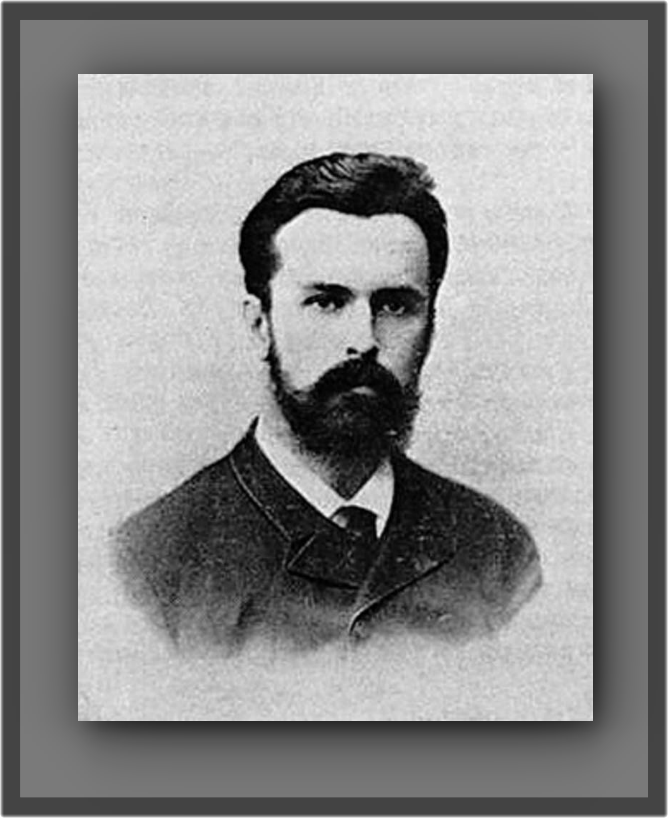
Prince Evgenii Nikolaevitch Troubetzkoy (1863-1920) Russian philosopher.
IMAGE LINKED: wikimedia Attribution 4.0 International (CC BY 4.0)
There it is, showing us what the red logic of hell means when it works itself out in action, and what results follow when the Mystic Tie of spiritual faith and fellowship is cut.
Political anarchy, social animalism, moral bedlam follow with mathematical certainty, and all the fine and holy things of life are thrown into the junk heap.
Man has an animal inheritance – moods of ape and tiger mingle in him with divine dreams and thoughts that wander through eternity – and when the Divine is denied, he reverts to the law of the jungle, and the hard-won trophy of spiritual struggle and agony vanishes. What happens, happens again.
The Bolshevists [Bolsheviks] are men of like passions as ourselves; they simply carry out with the fatal logic of fanaticism the dogma of materialism upon which we have been trying to base our modern civilization.
If anyone thinks that what has taken place in Russia cannot happen in America, he knows little of history and less of human nature.

Program of the Russian Communist Party (Bolsheviks). 1919
IMAGE LINKED: wikimedia Attribution 4.0 International (CC BY 4.0)
The practical denial of the Divine dehumanizes humanity, and the rest follows as night follows day.
For that reason, if it should be a part of our religion to be patriotic, it must be a part of our patriotism to keep the light of spiritual faith aflame on the altars built by our fathers.
Down in Wales, at a time when it seemed that revolution was inevitable, I asked a labour leader what bond held men together.
He said:
“All that holds these men back is the fact that they were trained in the Sunday-schools of these Welsh chapels years ago. That is all that keeps the spark from blowing up.”
Within the last four years ten thousand Sunday-schools have ceased to exist in America, and the end is not yet.
Facts such as these, and others of like kind, make a thoughtful man wonder as to what the future will be. What confronts us is not specifically indifference to religion, but indifference to pretty well everything outside the circle of creature comfort and self-gratification.
There are many exceptions, of course, but in the main it is true that society has as yet been able to persuade only a few of its members to be really interested in its higher concerns.
By the same token, men who do care for what is finest in our national life must make use of every opportunity, every instrumentality, to keep alive the faith that makes men faithful, and the vision of the moral ideal that lights our human way toward the city of God.
There is no need to apply what has been said, least of all to men to whom the Mystic Tie is a reality, and who are bound together by it in a fraternity of spiritual Faith and Fellowship.
In every degree of Freemasonry we are taught – by art, by drama, by symbol – the moral basis of human society, its spiritual interpretation, and the necessity of a fraternal righteousness among men, without which manhood is rudimentary and intellectual culture is the slave of greed and passion.
Of Lincoln it was said, that “his practical life was spiritual,” and by as much as Masonry builds men of like faith and fibre who, in private life and public service, keep a manhood neither bought nor sold, true of heart and unbefogged of mind, it is helping to weave that Mystic Tie that holds the republic together.
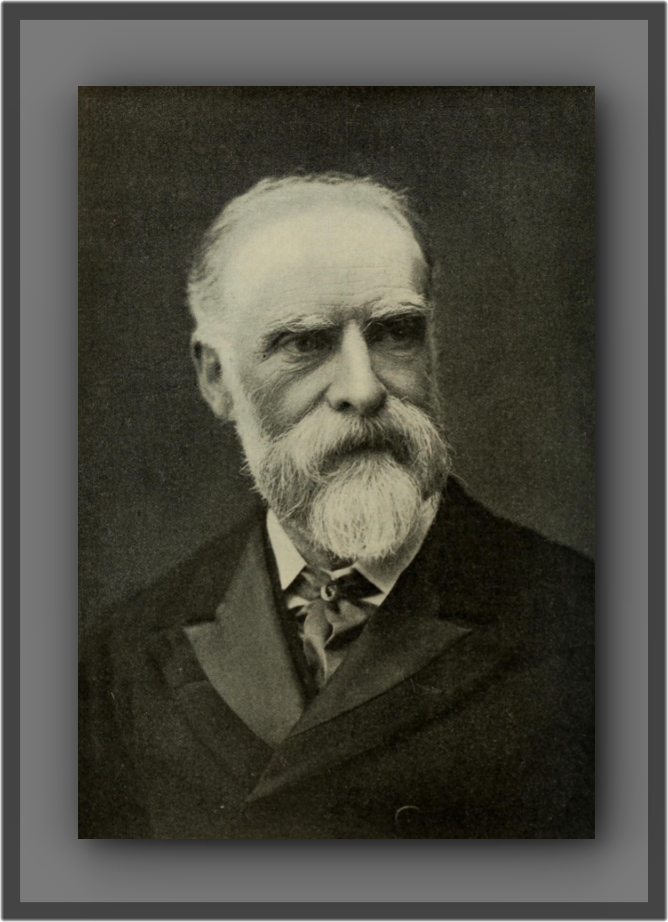
James Bryce, 1st Viscount Bryce
IMAGE LINKED: archive.org Attribution 4.0 International (CC BY 4.0)
The words of James Bryce, in The American Commonwealth, ought to be written and hung up in our hearts:
If history teaches anything, it teaches us that hitherto civilized society has rested on religion.
It was religious zeal and religious conscience that led to the founding of the New England colonies two centuries and a half ago.
Religion and conscience have been a constantly active force in the American Commonwealth ever since.
And the more democratic republics become, the more the masses grow conscious of their power, the more do they need to live not only by patriotism, but by reverence and self-control, and the more essential to their well-being are those sources from which reverence and self-control flow.
Article by: Joseph Fort Newton
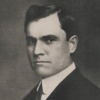
Rev. Newton (1880–1950) , was an American Baptist minister, authored a number of masonic books, including his best-known works, The Builders, published in 1914, and The Men’s House, published in 1923.
He received the third degree of Freemasonry on May 28, 1902 in Friendship Lodge No. 7, Dixon, Illinois, later affiliating with Mt. Hermon Lodge No. 263, Cedar Rapids, Iowa.
He also served as Grand Chaplain of the Grand Lodge of Iowa from 1911 to 1913 and Grand Prelate of the Grand Encampment of Knights Templar.
The Builders has been called "an outstanding classic in Masonic literature offering the early history of Freemasonry."

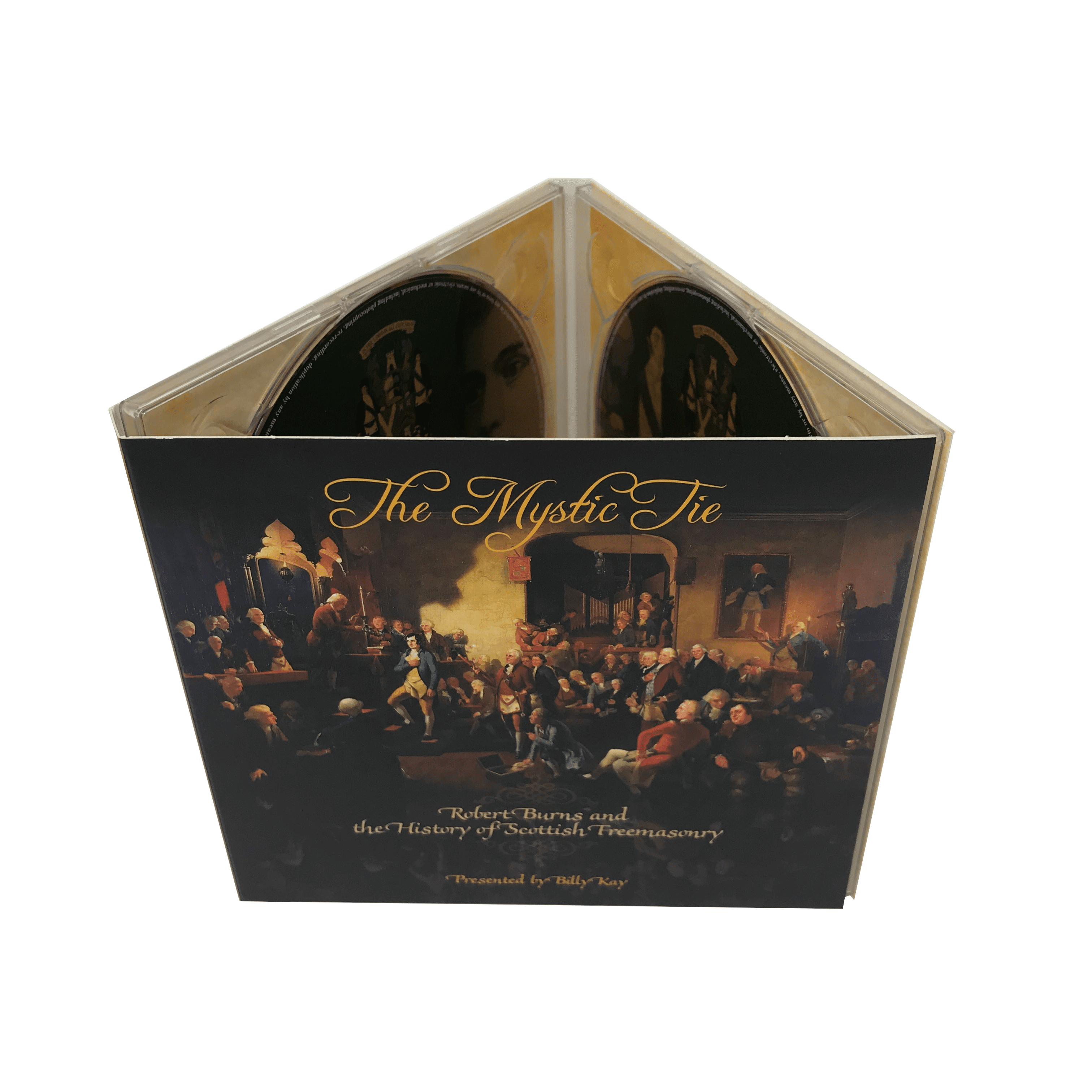
The Mystic Tie (CD)
The Grand Lodge of Scotland
The Mystic Tie is a double CD (audio) commissioned by the Grand Lodge of Scotland from the award winning writer and broadcaster, Billy Kay. He is not a Freemason.
This attractive double CD explores the world of Scottish Freemasonry through the words of ‘ordinary’ Scottish Freemasons and one of the CD’s is devoted to exploring the impact that Freemasonry had on the life and world of Brother Robert Burns.
These CDs have been produced as part of the Grand Lodge of Scotland’s contribution to Home Comming Year so called to mark the 250th anniversary of the birth of Brother Burns and to which all those who love Scotland have been invited to attend any of the various functions arranged for 2009.

The American Commonwealth
By: James Bryce
This scarce antiquarian book is a facsimile reprint of the original. Due to its age, it may contain imperfections such as marks, notations, marginalia and flawed pages. Because we believe this work is culturally important, we have made it available as part of our commitment for protecting, preserving, and promoting the world’s literature in affordable, high quality, modern editions that are true to the original work.
Recent Articles: Masonic Miscellanies
 Masonic Miscellanies - The Amulet of the Ladder Explore the cosmic significance of the Ladder in ancient Egyptian mythology through Wallis Budge's "Egyptian Magic." Discover how this profound symbol bridges the mortal and divine, encapsulating the Egyptians' fervent afterlife aspirations with a blend of myth, magic, and material culture. Dive into the celestial ascent of Osiris and mortal souls. |
 Masonic Miscellanies - Adulterine Gilds Guilds, the associations that shaped medieval European society, were more than just organizations of artisans and merchants. They played a vital role in the economic and social development of towns and cities. This exploration delves into the intriguing concept of adulterine gilds and their interconnectedness with guilds, offering insight into the significance of legal authorization and recognition in medieval Europe. |
 Masonic Miscellanies - Masonic Orb Discover the fascinating world of Masonic ball watch fobs, intricately crafted with tiny pyramids that form a cross when opened. These decorative accessories were all the rage in the late 1800s and early 1900s, and they still hold a certain allure today. Explore the different varieties and symbols found on these unique pieces that carry deep Masonic meaning. |
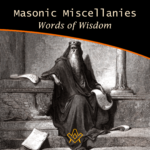 Masonic Miscellanies – Words of Wisdom Uncover timeless wisdom from King Solomon to Albert Pike in our latest Masonic Miscellanies, a treasure trove of insights for Masons. Journey through the ages and glean inspiring sayings, reflecting on their profound influence on Masonic principles. An enriching read for the enlightened. |
 Masonic Miscellanies - Symbolism of the Right Hand Unlock the enigmatic realm of Freemasonry as we delve into its age-old symbols, rituals, and philosophies. This thought-provoking exploration, drawn from Mackey's Revised Encyclopedia of Freemasonry, focuses on the iconic 'right hand' symbol - its rich history, universality, and profound significance. |
 Masonic Miscellanies - Order of the Secret Monitor Unveil the mystery of Freemasonry with 'The Order of the Secret Monitor'. Discover this lesser-known appendant order, its unique rituals, and the profound teachings it offers. Explore the bonds of friendship and brotherhood it fosters, all wrapped in an intriguing cloak of mystery. Your journey into the depths of Masonic wisdom begins here. |
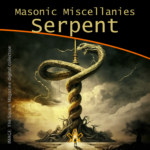 Masonic Miscellanies - The Symbol of the Serpent As a symbol, the serpent obtained a prominent place in all the ancient initiations and religions. |
 Masonic Miscellanies - The Four Veils in Royal Arch Masonry What are the four veils in Royal Arch Masonry? And what is the 'Ceremony of Passing the Veils'? Although common throughout Scotland, Ireland and the United States, it is mostly unknown in England, presently only worked in the Province of Bristol. ( and by dispensation ) |
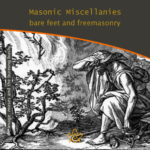 Masonic Miscellanies - Bare feet and Freemasonry A candidate for initiation into a Masonic Lodge often finds the requirements which he/she must fulfil somewhat odd. The mode of preparation often remains a puzzle, since the ritualistic explanation is not offered in full. Why are we 'slipshod' or "bare-footed" in Masonic Ritual? |
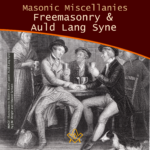 Masonic Miscellanies – Freemasonry and Auld Lang Syne Millions of people throughout the world will sing Auld Lang Syne to see out the Old Year. Few will know all the words, fewer still know what they mean, or that there is a link to Freemasonry. |
 Masonic Miscellanies - The Mosaic Pavement - why mosaic, why pavement? We are all familiar with the black and white chequered flooring of the Masonic lodge but where did it originate? There are a few theories… |
 Masonic Miscellanies – Masonic Master's Carpets Have you got a magic "Masonic Master's Carpet" in your lodge? I say 'magic' with my tongue firmly in my cheek because (as far as I know) these fabulous works of art don't bestow any mystical powers but can bestow some educational ones! However, considering their possible value today, they may magic up some interest (or funds). |
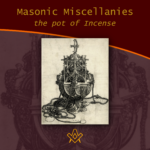 Masonic Miscellanies – The Pot of Incense Just when the pot of incense became an emblem of the third section of the Sublime Degree can not be stated with certainty. It is, apparently, an American invention or addition. But what does it symbolise? |
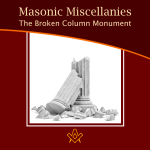 Masonic Miscellanies - The Broken Column Monument The story of the broken column was first illustrated by Amos Doolittle in the "True Masonic Chart" by Jeremy Cross, published in 1819. |
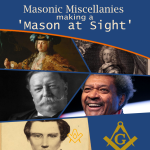 Masonic Miscellanies - Making a 'Mason at Sight' What does it mean to make a 'Mason at sight', and who was made one? |
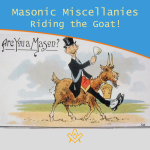 Masonic Miscellanies - Riding the Goat! Many Freemasons will have come across the phrase 'riding the goat', and will no doubt have been the butt of a joke about it (sorry, I couldn't resist!) But what does it mean and where did the phrase come from? |
 Masonic Miscellanies - What are the 'three dots'? Three dots or points in an upright triangular shape ∴ is most commonly known as the 'therefore' sign – so why is it used in Freemasonry? |
 Masonic Miscellanies - Keep Within Compass This month we discover a series of allegorical prints warning us to "Keep within Compass and you shall be sure, to avoid many troubles which others endure." |
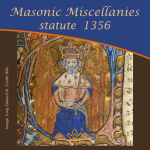 Masonic Miscellanies - statute 1356 Further to the reference in the article – The Builders - 6 - Free-Masons 'a statute was enacted against the Free-masons in 1356' – Regulations for masons who are hewers, on the one hand, and the light masons and setters on the other. |
 Masonic Miscellanies - An Anti-Masonic 'Apron'? The Anti-Masonic 'Apron' was created during the 1832 Presidential election in USA. It was not Ani-masonic. And it was not an apron. Read on to find out what and why it was created. |
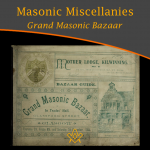 Masonic Miscellanies - Grand Masonic Bazaar (1895) Grand Masonic Bazaar (1895); to raise funds to clear the debt incurred by “Mother Kilwinning” in rebuilding their Lodge. |
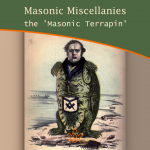 Masonic Miscellanies - the 'Masonic Terrapin' A satirical book from 1851 includes a bizarre caricature of a 'Masonic Terrapin' - all I can say is 'read on'… |
 Masonic Miscellanies - Masonic Bookplates You probably know what a bookplate is for, but did you know that the earliest known book mark/label dates from the reign of Amenhotep III in Egypt around 1391−1353 BCE?! |
 Masonic Miscellanies - Freemasonry & Bees Freemasonry & Bees - what's the buzz? The bee was among the Egyptians the symbol of an obedient people, because, says Horapollo, of all insects, the bee alone had a king. |
 Masonic Miscellanies - The mystery of the Tattooed Freemason In 1894, the body of a drowned man was found in the Bay of San Francisco - what they discovered was amazing. |
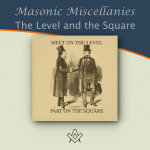 Masonic Miscellanies - The Level and the Square (A Poem) The Level and the Square (A Poem) - "We meet upon the Level, and we part upon the Square – |
 Masonic Miscellanies - The Mystic Tie What is the 'Mystic Tie'? Clue: it's not an item of neckwear! |
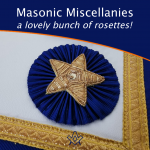 Masonic Miscellanies - A lovely bunch of rosettes! Where did the origin of the use of rosettes on Masonic aprons come from ? |
 Masonic Miscellanies - The Lodge of Sorrow The Lodge of Sorrow - Extracted General Ahiman Rezon, by Daniel Sickles, [1868] |
 Masonic Miscellanies - Memento Mori Memento Mori - a Masonic reminder to make your mark on the world |
 Masonic Miscellanies - A closer look at the Level and the Plumb-rule A closer look at the Level and the Plumb-rule |
 Masonic Miscellanies - The Symbolism of the Gloves The Symbolism of the Gloves and why Freemasons wear white gloves |
 Masonic Miscellanies - Will the real James Anderson please stand up? Will the real James Anderson please stand up? |
 Masonic Miscellanies - The Legend of the Third Degree The most important and significant of the legendary symbols of Freemasonry is, undoubtedly, that which relates to the fate of Hiram Abif. |
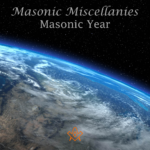 Masonic Miscellanies - Masonic Calendar Why do Freemasons use different 'years' to our regular calendar? |
 Masonic Miscellanies - What is a 'Lewis'? The English word 'Lewis' is a term belonging to operative Masonry, and signifies an iron cramp, which is inserted in a cavity prepared for the purpose in a large stone. |
 Masonic Miscellanies - From J.S.M. Ward Ever wondered why masons had to be 'free' or why we have a Tyler? |
Recent Articles: The Builders by Joseph Fort Newton
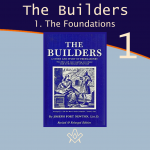 The Builders – 1 The Foundations Chapter 1. The Foundations Explore an outstanding classic in Masonic literature - an exposition of the early history and symbolism of Freemasonry – from the foundations upwards. |
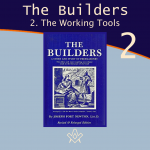 The Builders – 2 The Working Tools Chapter 2. The Working Tools - Explore an outstanding classic in Masonic literature - an exposition of the early history and symbolism of Freemasonry – from the foundations upwards. |
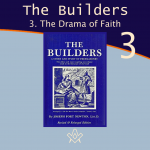 The Builders – 3 The Drama of Faith Chapter 3. The Drama of Faith - Explore an outstanding classic in Masonic literature - an exposition of the early history and symbolism of Freemasonry – from the foundations upwards. |
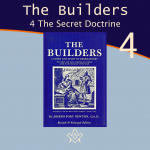 The Builders – 4 The Secret Doctrine Chapter 4. The Secret Doctrine - Explore an outstanding classic in Masonic literature - an exposition of the early history and symbolism of Freemasonry – from the foundations upwards. By Joseph Fort Newton |
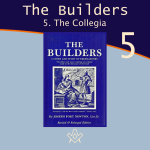 Chapter 5. The Collegia - If the laws of building were secrets known only to initiates, there must have been a secret Order of architects who built the temple of Solomon. Who were they? |
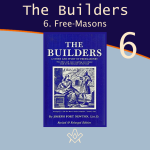 The Builders – 6 The Free-Masons Chapter 6. the Free-Masons - an examination into the history of the medieval guilds, their charges and regulations that form the base for the allegories and symbols in our modern versions of masonic craft ritual. By Joseph Fort Newton |
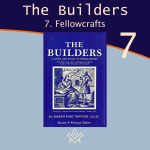 Chapter 7. the Fellowcrafts - an examination into the history of the medieval guilds, their charges and regulations that form the base for the allegories and symbols in our modern versions of masonic craft ritual. By Joseph Fort Newton |
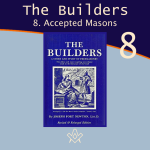 The Builders – 8 Accepted Masons Chapter 8. Accepted Masons - an examination into the history of accepted masons, and why did soldiers, scholars, antiquarians, clergymen, lawyers, and even the nobility ask to be accepted as members of the order of Free-masons? By Joseph Fort Newton |
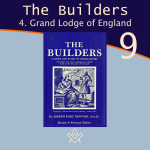 The Builders – 9 Grand Lodge of England Chapter 9. Grand Lodge of England - From every point of view, the organization of the Grand Lodge of England, in 1717, was a significant and far-reaching event. By Joseph Fort Newton |
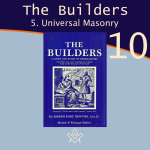 The Builders – 10 Universal Masonry Chapter 10. Universal Masonry - Henceforth, the Masons of England were no longer a society of handicraftsmen, but an association of men of all orders and every vocation, as also of almost every creed, |
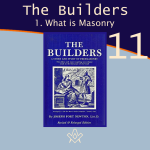 The Builders – 11 What is Masonry Chapter 11 "Masonry is the activity of closely united men who, employing symbolical forms borrowed principally from the mason's trade and from architecture, work for the welfare of mankind, striving morally to ennoble themselves and others, and thereby to bring about a universal league of mankind, which they aspire to exhibit even now on a small scale." |
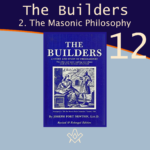 The Builders – 12 The Masonic Philosophy Chapter 12 When we look at Masonry in this large and mellow light, it is like a stately old cathedral, gray with age, rich in associations, its steps worn by innumerable feet of the living and the dead—not piteous, but strong and enduring. By Joseph Fort Newton |
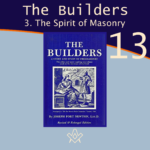 The Builders – 13 The Spirit of Masonry Chapter 13 Masonry is Friendship—friendship, first, with the great Companion, of whom our own hearts tell us, who is always nearer to us than we are to our-selves, and whose inspiration and help is the greatest fact of human experience. |
masonic knowledge
to be a better citizen of the world
share the square with two brothers

click image to open email app on mobile device
Tubal Cain
Masonic Aprons NFT
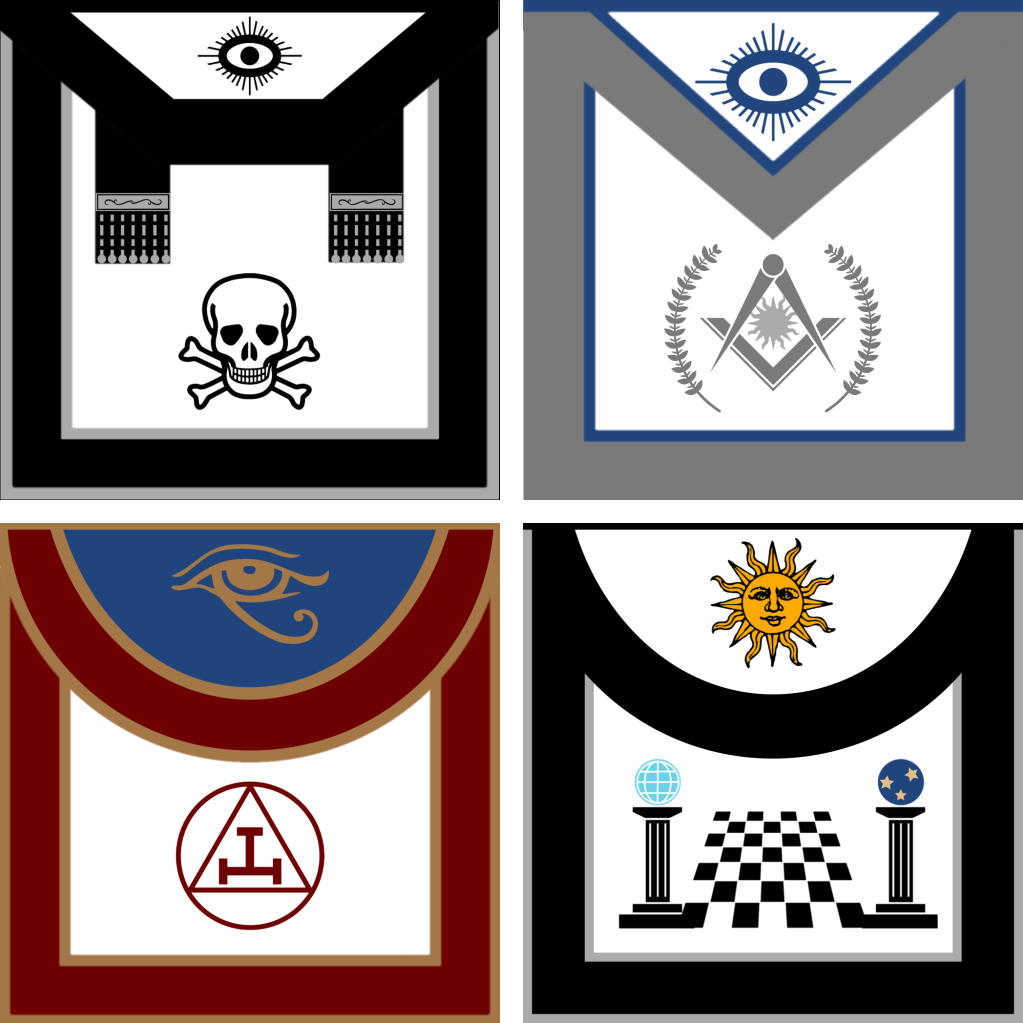



Each Tubal Cain Masonic Apron NFT JPEG includes a full size masonic apron and worldwide shipping
